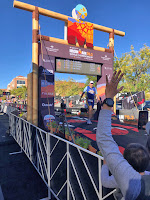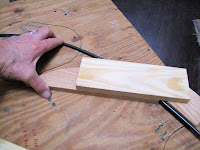I have been working slowly on finishing both elevators.
The end of the 3/4" tube welded to the horn needs to be flattened to fit the 5/16" Trailing Edge tube. It's important that the horn be reasonably square to the L.E. & T.E. tubes, so the flattening needs to be on the sides of the tube which align with the ends of the horn. To mark this I started with a blue line on those sides of the tube. Then I set the horn tabs on a piece of 3/4" so it couldn't rock and just used my small square to rub lines in the blued sides.It's a thin line but I found it easier to use as a guide than just holding the horn vertical while hammering the tube sides. The line is more in my line of sight while hammering.
With the rib tube flattened to fit the 5/16" TE tube I marked a cut line just inboard of the TE center.
When the tubes fit tightly, the horn sets square. I used a 5/16" chainsaw file to fish mouth the end of the tube. I'd like to see the saw that needs a 5/16" file.
Ready to tack weld the first elevator. I started by tacking the Trailing Edge tube to the Spar then tacking everything to the TE, then to the Spar. It allowed me to tape things to the spar to hold them tight to the TE.
Everything is tacked ready to remove from the jig and finish all the welds.
Fitting up the second elevator in the jig.
When the tubes fit tightly, the horn sets square. I used a 5/16" chainsaw file to fish mouth the end of the tube. I'd like to see the saw that needs a 5/16" file.
Ready to tack weld the first elevator. I started by tacking the Trailing Edge tube to the Spar then tacking everything to the TE, then to the Spar. It allowed me to tape things to the spar to hold them tight to the TE.
Everything is tacked ready to remove from the jig and finish all the welds.
Fitting up the second elevator in the jig.
Tack welded.
A tack on the front of a rib tube, and on the leading edge of the horn.
With everything else welded there were 2 small tabs to add to each spar. They get bent around a small block of poplar and pulled tight with a machine screw and nut. The block of wood has a slot for the hinge strap to slip through and the wood provides a place to tack the fabric covering to. I'll probably use epoxy varnish on the wood, no varnish on the old one, and glue the fabric to it rather than tack it on.
A tack on the front of a rib tube, and on the leading edge of the horn.
With everything else welded there were 2 small tabs to add to each spar. They get bent around a small block of poplar and pulled tight with a machine screw and nut. The block of wood has a slot for the hinge strap to slip through and the wood provides a place to tack the fabric covering to. I'll probably use epoxy varnish on the wood, no varnish on the old one, and glue the fabric to it rather than tack it on.
I used a piece of 3/16" square steel to space the inboard tab from the rib. I needed all the clearance I could get to get in between the rib tube to weld the back side of the tab. There is no weld on the other side leaving a clear area for the wood block.
I cut a piece of 1/2" tubing to 2 3/8' and ground the ends square on the belt sander to space the second tab to fit the block. I do have a factory drawing for the block.































































